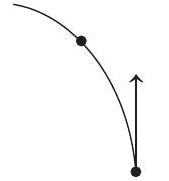Magnetics 1 Question 22
22. $H^{+}, He^{+}$and $O^{2+}$ all having the same kinetic energy pass through a region in which there is a uniform magnetic field perpendicular to their velocity. The masses of $H^{+}, He^{+}$and $O^{2+}$ are $1 amu, 4 amu$ and $16 amu$ respectively. Then
(a) $H^{+}$will be deflected most
$(1994,2 M)$
(b) $O^{2+}$ will be deflected most
(c) $He^{+}$and $O^{2+}$ will be deflected equally
(d) all will be deflected equally
Show Answer
Answer:
Correct Answer: 22. (a, c)
Solution:
$$ r=\frac{m v}{B q}=\frac{p}{B q}=\frac{\sqrt{2 K m}}{B q} \text { i.e. } r \propto \frac{\sqrt{m}}{q} $$

If $K$ and $B$ are same. i.e., $\quad r _{H^{+}}: r _{He^{+}}: r _{O^{2+}}=\frac{\sqrt{1}}{1}: \frac{\sqrt{4}}{1}: \frac{\sqrt{16}}{2}=1: 2: 2$
Therefore, $He^{+}$and $O^{2+}$ will be deflected equally but $H^{+}$ having the least radius will be deflected most.






